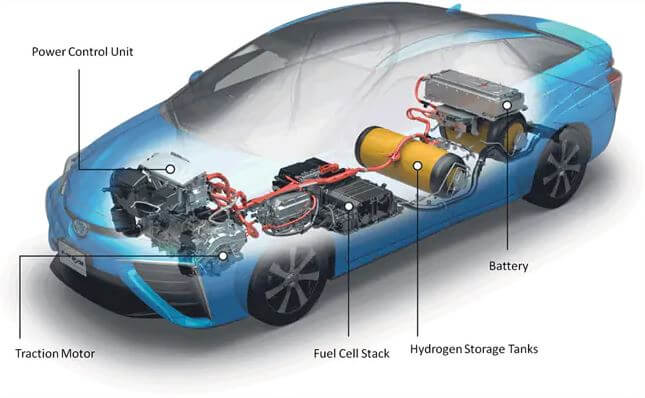Describe Three Issues With Using Fuel Cells in Automobiles
The hydrogen fuel cell electric vehicle FCEV which simply runs on pressurised hydrogen from a fuelling station produces zero carbon emissions from its exhaust. Being a pioneer can be tough and the first on the road in fuel cell vehicles are learning that the hard way.

Analysis Of Hydrogen For The Automotive Industry Lions Financial
Fuel Cell Durability and Reliability.
. Hyundais Toyotas and Hondas fuel-cell electric vehicles may be new to the streets but much of the technology they carry is not at all new because these cars have a great deal in common. List of the Disadvantages of Hydrogen Fuel Cells 1. It can be filled as quickly as a fossil-fuel equivalent and offers a similar driving distance to petrol.
Audi has previewed several fuel cell concepts at auto shows in recent years including the h-tron quattro concept it showed at 2016 NAIAS in Detroit. All the challenges for hydrogen fuel-cell cars laid out Green Car Reports April 3 2017 Comment Now. PEM fuel cells are the best candidates for powering automobiles.
The first was the Hyundai ix35 in early 2013 and then came the Toyota. Larger fuel cells are also being used to provide backup power for hospitals credit card centers police stations and similar large-scale facilities. The two prime dangers from fuel cell and hydrogen-powered vehicles are the danger of electrical shock and the flammability of the fuel.
Fuel cells can supply power for indefinite length of time while battery supplies power for definite length of time. Switching over to hydrogen fuel cells helps to reduce the exposure risks because the same energy becomes useful over a variety of applications. Plus fuel cells operate quietly have fewer moving parts and are well-suited for various kinds of applications.
Waste water treatment plants and landfills make use of fuel cells to capture and convert the methane gas they produce into electricity. At the same time the fuel economy of hydrogen fuel cells is about twice that of standard gasoline. As a result there is more than a 50 reduction in fuel consumption.
It has a much better fuel economy compared to gasoline. Fuel cells power vehicles by electro-chemically combining hydrogen gas H2 and oxygen O2 from the surrounding air into water H20 and electrical energy. Similar to conventional cars fuel cell cars also have a quite short fueling time.
Refueling times are too long. Twenty years ago Toyota took the automotive industry by surprise with the Prius. They can also be used for stationary power production.
However due to their low operating temperature they cannot directly use hydrocarbon fuels such as natural gas liquefied natural gas or ethanol. Assuming the same maintenance cost and lifetime methanol-fueled fuel cell vehicles became the most economically feasible among these three fuel cell vehicles after at least 2-year use. Vehicles that use hydrogen fuel cells and also use electric motors are more efficient as they can use 40 to 60 percent of the fuels energy.
We need to store our fuel resources at the moment so that we can use them when they are needed. Check out Autos Cheat Sheet on Facebook and Tumblr Follow Eric on Twitter EricSchaalNY. The cost of on-board hydrogen storage systems is too high particularly in comparison with conventional storage systems for petroleum fuels.
Hydrogen has long been touted as the future for passenger cars. Fuel cell systems are not yet as durable as internal combustion engines and do not perform as well in extreme environments such as in sub-freezing temperatures. Fuel cell require more space as reactants stored outside while battery require less space.
The fuel cost for hydrogen-fueled fuel cell vehicles is more than 74 more expensive than that for methanol- or gasoline-fueled fuel cell vehicles. Telecommunications companies have started using fuel cells. Fuel cells One of the key issues preventing mass commercialization of fuel cells is the high cost of the system.
H igh manufacturing costs less-than-optimal efficiency in production and manufacturing and complicated storage and transport requirements have also held back hydrogen fuel cells from becoming a widely adoptable technology for consumer vehicles. Compared to electric cars for which it can take up to 30 minutes to fuel you could save plenty of time by using fuel cell cars instead. Fuel cells works as long as fuel is supplied while battery require regular replacements.
Meanwhile news of a breakthrough in hydrogen on-board storage looked like mitigating a major problem with fuel-cells and cars the huge cost of safe and adequate storage. It only takes a few minutes until a hydrogen car will be refueled. Hydrogen fuel cells provide a performance that is similar to gasoline so there is no change to how the typical passenger vehicle handles when it is using this fuel option.
With the recent arrival of the Honda Clarity there are now three automakers offering cars powered by hydrogen fuel cells. It has some heavyweight backing. Energy Procedia 28 2012 2 11 5 23.
There is a need to develop hydrogen storage systems with refueling times of less than three minutes over the lifetime of the system. Hydrogen fuel cells do not work in every situation as of yet.

Fuel Cell Vehicles Automobiles

Why The Automotive Future Will Be Dominated By Fuel Cells Ieee Spectrum
Hydrogen Fuel Cell Vehicles Sensational Hype Or Revolutionary Transportation Institute On The Environment
No comments for "Describe Three Issues With Using Fuel Cells in Automobiles"
Post a Comment